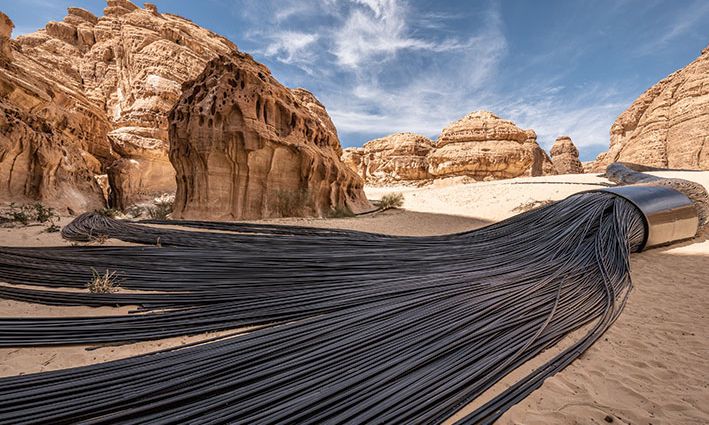Muhannad Shono’s The Lost Path (2020) was installed at the first edition of Desert X Al Ula Lance Gerber
“I never expected to represent Saudi at the Venice Biennale,” says Muhannad Shono. An artist who has been unafraid to critique the country’s social restrictions—now easing under Crown Prince Mohammed bin Salman—Shono takes his nomination by Saudi Arabia a sign of “how big the changes are for all those who now feel free to question and create”.
Shono’s work at the Saudi pavilion is a metaphor for transformation—an important topic in the country at large and its visual arts scene in particular. For Shono, who is one of the major figures on the art scene, the work builds on long-standing interests: in particular what he refers to the “line”, a horizontality that recurs throughout his typically large-scale installation practice.
Operating as a gestural mark, the idea of a line is for Shono a sign of creativity, grounded in an ink-like black palette. It appears, for example, in his winding installation, The Lost Path, for the first Desert X Al Ula exhibition in 2020, a slick, tangled trawl of black pipes that brought to mind oil slithering down the valley, and in his robotic arm for the Diriyah International Biennale, painting a floor-sized canvas black.
Reem Fadda, the co-curator of Desert X Al Ula 2022 and the director of the Cultural Foundation in Abu Dhabi, has curated this year’s pavilion—Saudi Arabia’s third at the art biennial. Commissioned by the country’s Ministry of Culture, it perhaps reflects more straightforwardly on the Saudis’ social and political shift than one might have expected. But for Saudi artists, the speed of the changes is fast becoming a subject in itself.
Artist: Muhannad Shono
Organisers: Reem Fadda; Visual Arts Commission, Ministry of Culture
Where: Arsenale

